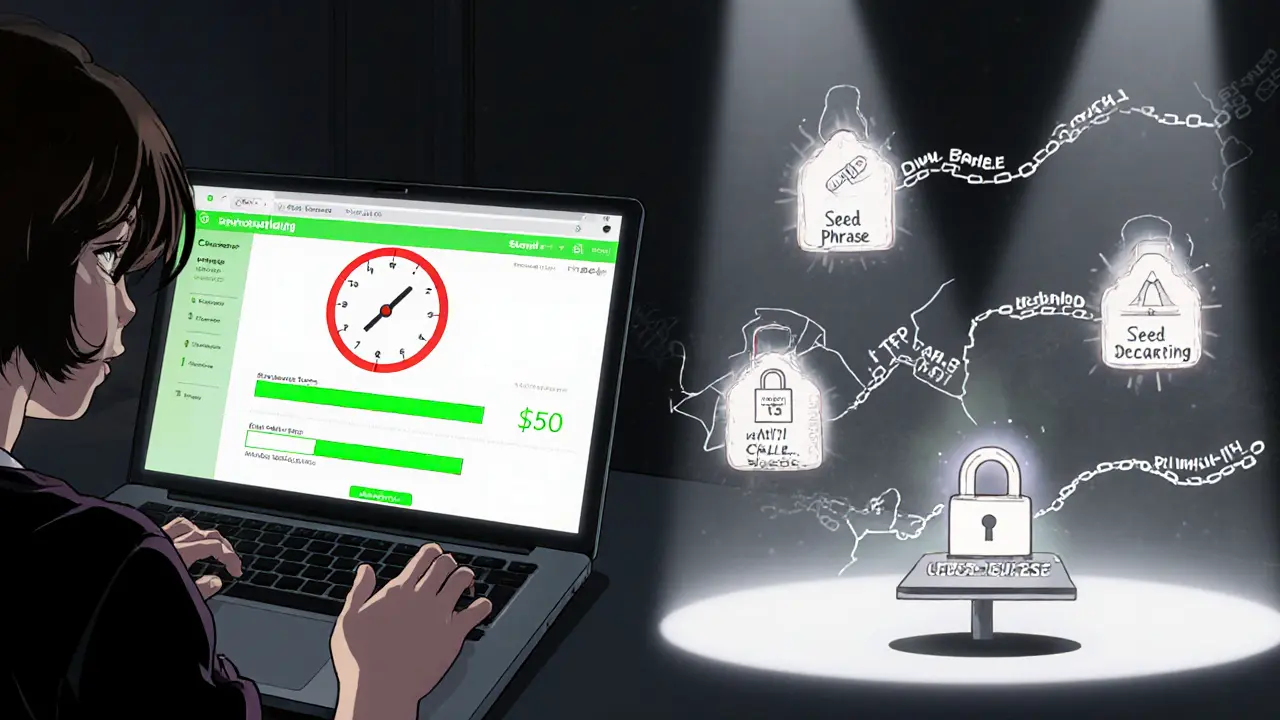Web3 Adoption Challenges 2025 and How to Overcome Them
 Oct, 15 2025
Oct, 15 2025
Gas Fee Estimator for Web3 Transactions
Transaction Cost Calculator
Estimate gas fees for Ethereum and Layer-2 transactions compared to Web2 alternatives
Cost Analysis
Why This Matters
High gas fees make micro-transactions uneconomical. As noted in the article, Ethereum average gas fees reached $1.20 per transaction in Q3 2025, while Visa handles 65,000 TPS with near-zero costs. Layer-2 solutions like Optimism have reduced fees by 90%, bringing costs closer to $0.01 for many use cases.
For context, the article states that 83% of gamers abandon the flow before completing wallet creation due to these friction points.
When people talk about Web3 is a decentralized internet vision that puts data ownership, identity and digital assets in the hands of users, the excitement is real - but the road to mass use is still littered with hurdles. In 2025, only about 6% of global internet users are actively interacting with decentralized apps, and most of them hit a wall before they can see real value. This guide breaks down the biggest blockers, shows why they matter, and points to practical ways the ecosystem is trying to clear the path.
Key Takeaways
- Scalability remains the toughest technical obstacle; most blockchains stay under 100transactions per second.
- High gas fees and slow finality make everyday micro‑transactions uneconomical.
- Onboarding requires 3‑5 extra steps compared with Web2, causing steep drop‑off rates.
- Fragmented interoperability and frequent smart‑contract exploits keep enterprise confidence low.
- Regulatory uncertainty and limited education affect both users and Fortune‑500 pilots.
1. Scalability and Performance Gaps
The Blockchain a distributed ledger that records transactions in a tamper‑proof chain trilemma forces a trade‑off between security, decentralization and speed. As of October 2025, the majority of public chains process fewer than 100TPS, while Ethereum, the biggest platform for decentralized apps, hovers between 15‑30TPS. By contrast, Visa handles roughly 65,000TPS. Even optimistic Layer‑2 solutions such as Optimism and Arbitrum only reach 2,000‑4,000TPS, still far from the sub‑second, high‑throughput experience users expect.
These limits manifest in long confirmation times - 6minutes for Bitcoin and about 15seconds for Ethereum - turning simple actions like token swaps into a waiting game. Without breakthroughs that push throughput toward the 100,000TPS benchmark set by the World Economic Forum, mainstream commerce will stay out of reach.
2. Transaction Costs and Economic Viability
Gas fees on Ethereum spiked to $50‑$100 during the August 2025 DeFi frenzy, according to Etherscan data. The average fee settled at $1.20 per transaction in Q3 2025, a stark contrast to the near‑zero cost of a Web2 API call. For micro‑payments - think paying a few cents for a digital article - such fees are prohibitive.
Storage pricing adds another layer of friction. IPFS‑based solutions like Filecoin charge roughly $0.15 per gigabyte per month, while traditional cloud providers offer 1TB for $7. The disparity makes long‑term data archiving on‑chain economically unattractive for most apps.
3. User Experience and Onboarding Friction
Getting started with a decentralized app usually means creating a crypto wallet, securely writing down a seed phrase, and manually selecting a network - a process that adds 3‑5 steps beyond a typical email‑and‑password signup. A BeInCrypto UX study (August 2025) found that 83% of gamers abandon the flow before completing wallet creation.
Complex interfaces also drive errors. Trustpilot reviews for leading wallets average 2.8/5 stars, with 67% of negative feedback citing "confusing UI" and "lost funds due to user error." When users do manage to navigate the steps, high slippage and fee miscalculations still cause costly failures, as highlighted by a Reddit post where a $47 transaction was lost to a gas‑price mistake.

4. Interoperability and Fragmentation
Today’s Web3 ecosystem is a patchwork of dozens of independent blockchains. Cross‑chain bridges currently enable only about 12% of potential asset transfers because of protocol mismatches and security concerns (Blockchain Interoperability Alliance, Oct2025). This siloed landscape prevents seamless user experiences and forces developers to duplicate effort across multiple networks.
Even within a single ecosystem, standards vary. While Ethereum’s ERC‑20 token standard is widely adopted, newer chains like Sui and Aptos use entirely different contract models, complicating developer tooling and increasing onboarding hurdles.
5. Security Risks and Smart‑Contract Exploits
Smart‑contract vulnerabilities remain a headline risk. CipherTrace reported $1.2billion stolen in Q3 2025 alone, with 347 documented exploits according to PixelPlex. These breaches dwarf the $380million in comparable Web2 data‑breach losses, eroding trust among both consumers and enterprises.
Auditing costs are steep - a thorough audit can run $150,000‑$200,000 - and many startups cannot afford it. The resulting "code‑first" mentality often pushes products to market without rigorous testing, leading to higher failure rates (47% higher than Web2 benchmarks).
6. Regulation and Legal Uncertainty
Regulators worldwide are still catching up. While 87 countries now have some form of crypto framework (IMF Regulatory Tracker, Sept2025), the rules differ dramatically on topics like securities classification, AML/KYC obligations, and tax treatment. Deloitte’s 2025 enterprise survey showed 78% of Fortune‑500 firms pause Web3 pilots due to unclear compliance pathways.
In the U.S., the SEC’s ongoing enforcement actions against unregistered token sales have created a chilling effect for projects seeking institutional backing. Meanwhile, the EU’s MiCA regulation, effective in 2024, imposes stringent licensing requirements that many startups find prohibitive.
7. Education and Knowledge Gaps
Beyond technical barriers, a human factor dominates adoption charts. A BeInCrypto interview with Trust Wallet CEO Eowyn Chen highlighted user fear of losing funds and lack of perceived value. In surveys, 65% of potential users admit they “don’t understand how crypto works,” and the average learning curve to code a basic smart contract tops 120hours (Consensys Academy, Sept2025).
Fragmented community support - Discord (78% of queries), Telegram (15%), GitHub (7%) - leads to average response times of 8.2hours for critical issues, slowing developer onboarding and increasing frustration.

8. Mitigation Strategies and Emerging Solutions
Even with daunting obstacles, the ecosystem is actively tackling them:
- Layer‑2 scaling: Optimism’s recent upgrade cut transaction fees by 90%, bringing costs close to $0.01 for many use‑cases.
- Custodial wallets: Institutional custodians now offer one‑click onboarding, reducing user steps from five to one and cutting onboarding time by 63% for enterprise pilots.
- Cross‑chain bridges: Projects like Wormhole are integrating permissioned verification to raise successful transfer rates above 30%.
- Security audits: Automated formal verification tools (e.g., Certora) are lowering audit costs and catching bugs before deployment.
- Regulatory sandboxes: Countries such as Singapore and the UAE provide sandbox environments that let firms test compliant Web3 products without full licensing.
- Education platforms: Interactive tutorials from Consensys and Coursera now bundle gamified learning paths, shaving 30% off the average time to reach smart‑contract proficiency.
These measures are still early‑stage, but they illustrate a clear trajectory toward a smoother user experience and a more robust technical foundation.
Web2 vs Web3: A Quick Comparison
| Metric | Web2 | Web3 |
|---|---|---|
| Transactions per second | ~65,000 | 15‑30 (Ethereum), 2,000‑4,000 (Layer‑2) |
| Average transaction cost | ~$0.00 | $1.20 (Ethereum gas) |
| Onboarding steps | 1‑2 (email, password) | 3‑5 (wallet, seed phrase, network) |
| Failure rate | ~5% | ~47% (Google Lighthouse benchmark) |
| Regulatory clarity | High (global standards) | Low to medium (mixed jurisdictional rules) |
Future Outlook: When Might Mass Adoption Happen?
Experts agree that true consumer‑grade adoption won’t arrive until three technical thresholds are met: sub‑second finality, fees below $0.01, and 100,000TPS across interoperable networks. The World Economic Forum’s 2025 roadmap places those milestones around 2027‑2028 for enterprise‑focused use cases, while broader consumer uptake may stretch into 2030‑2032.
In the meantime, niche successes are already proving value: decentralized identity pilots cut fraud by 63% in EU banking, and tokenized assets achieve 98% settlement finality. These wins create footholds that, if paired with the scaling and UX improvements outlined above, can gradually expand the user base beyond the current 480million.
Frequently Asked Questions
Why are Web3 transaction speeds so slow compared to Web2?
Blockchains achieve security by requiring every node to validate each transaction, which adds latency. Current consensus mechanisms (Proof‑of‑Work, Proof‑of‑Stake) limit throughput to under 100TPS on most networks, whereas Web2 services use centralized servers that can process millions of requests per second.
What is the biggest cost driver for users on Ethereum?
Gas fees, which pay miners or validators for computation and storage, fluctuate with network demand. During peak periods in 2025, fees reached $50‑$100, making even modest transactions uneconomical.
How can I reduce the onboarding friction for my dApp?
Integrate custodial or social‑login wallets, offer one‑click account creation, and hide seed‑phrase handling behind secure backend services. Studies show these steps can cut drop‑off rates by more than 50%.
Is cross‑chain interoperability ready for production?
While bridges exist, only about 12% of potential transfers succeed without manual intervention. Emerging standards like Interledger and LayerZero aim to improve success rates, but wide‑scale reliability is still a work in progress.
What regulatory steps should a company take before launching a Web3 product?
First, map the jurisdictions where users will reside, then assess whether the token or service falls under securities, commodities, or utility classifications. Engaging a legal counsel familiar with MiCA, SEC guidance, and local AML rules is essential before any public deployment.

Ben Johnson
October 15, 2025 AT 09:17Wow, another gas fee apocalypse, what a surprise.